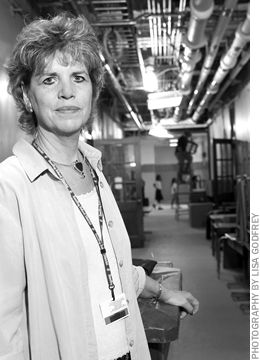 |
| Reading School District Superintendent Melissa Jamula is, by all accounts, a powerful advocate for the district with the local business community as well as local and state government leaders.
|
On December 11, 2003, the Reading, Pennsylvania, School District, on behalf of “our students and our schools,” said the superintendent, filed a “Petition for Review” with the Commonwealth Court of Pennsylvania. And in so filing, Reading became the first school district in the nation to sue a state education department over the No Child Left Behind (NCLB) Act.
There were cheers throughout the land as NCLB critics predicted a flood of suits to follow. Amicus briefs were filed on Reading’s behalf by the Pennsylvania State Education Association, the state’s largest teacher union; the Pennsylvania School Boards Association; and the Education Law Center-Pennsylvania.
“I applaud Reading,” Ira Weiss, special counsel for Pittsburgh Public Schools told the Pittsburgh Post-Gazette. “I think they are confronting the reality of this program.”
“A small but growing number of school systems around the country is beginning to resist the demands of President Bush’s signature education law,” reported the New York Times, which characterized Reading’s complaint against NCLB as having “unreasonably required the impoverished city to offer tutoring and other services for which there is no money.”
“It’s certainly going to be closely watched by all observers,” said Tom Hutton, a staff attorney for the National School Boards Association.
But more than six months later, as the Milwaukee Journal Sentinel reported, school districts had “pulled their punches” on taking action against NCLB. And Stateline.org, an online national newspaper covering state governments, reported that a rebellion in the legislatures of more than half the states had fizzled out. Despite all the saber rattling, said Steven Smith, an education expert with the National Conference of State Legislatures, by August of 2004 “there have been no takers.” The Reading district’s lawsuit “is the only one I’m aware of.”
Then, on August 6, eight months after Reading had filed its suit, Pennsylvania’s Commonwealth Court dismissed Reading’s complaint, affirming the state education department NCLB sanctions. “Essentially, the district is challenging aspects of NCLB that are within the purview of the Department’s expertise and discretion,” concluded Judge James Gardner Collins, “and this court will not disturb the exercise of such discretion unless it has been abused.” The Pennsylvania Department of Education in a statement said it was pleased with the ruling and was hopeful Reading would accept the result.
Incredibly, within a week of the ruling and with three weeks remaining on the deadline for filing an appeal to the Pennsylvania Supreme Court, the Reading School District filed a new complaint in Commonwealth Court challenging No Child Left Behind. The district’s lawyer, Rick Guida, said that the new complaint was filed because more schools in the district would face NCLB sanctions in the coming year and because the district had new evidence that the federal government was inadequately-and thus, illegally-funding the new law. But as close observers noticed, many of the same issues raised in the second lawsuit had already been litigated in the first one.
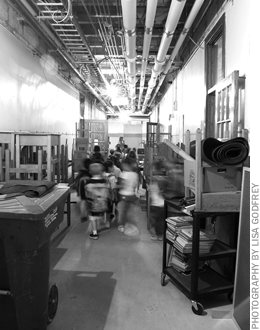 |
| While Reading’s student population had increased by 38 percent since 1990, its local property revenues dropped by 36 percent in just three years.
|
Why Reading?
At first, Reading seemed like the perfect place from which to mount a challenge to the new federal law. It was one of the state’s largest districts-with 16,500 students in 19 schools spread out over 9.6 square miles-and one of its most academically and demographically challenged. Some 64 percent of the student population was Hispanic, and nearly 11 percent had limited English ability. The dropout rate, 8.7 percent, was nearly four times the state average (which was 2.3 percent). The district’s passing rate of 31.2 percent for the Pennsylvania System of School Assessment test was, according to the state’s Education Department, “exceptionally below” the state average of 59 percent in 2002. In fact, only 1.8 percent of districts in Pennsylvania had a smaller proportion of test scores that met or exceeded state standards, according to an analysis by Standard & Poor’s for the state Department of Education.
But Reading’s real credentials as a poster child for the anti-NCLB movement derived from its fiscal problems. The district couldn’t pay its regular bills, let alone pay for NCLB. In fact, the once-prosperous transportation hub in southeastern Pennsylvania, like so many rust-belt towns, seemed to be a dying community and in no position to rescue a stranded school district. The city’s downward spiral included a high crime rate, businesses moving out and few moving in, and a declining tax base. Reading, population 80,000, was “in a state of shambles,” said Thomas Caltagirone, one of the city’s representatives to the state legislature, “on the brink of going belly up.”
Increasing the local tax burden was not an option to meet the demands of NCLB, school officials complained. In fact, while Reading’s student population had increased by 38 percent since 1990 (from 11,965 to 16,515), its local property revenues had dropped by 36 percent (from $39.4 million to $28.8 million) between 1997 and 2000. While the average district in the state saw its local revenue per student increase during this period, Reading’s decreased (see Figure 1). By 2002 the district faced a $5 million deficit, on revenues of $103 million. “Our hat was out, we were pleading,” said Caltagirone, recalling his pitch to fellow lawmakers, who agreed to bail out Reading. For 2004-05 the district’s total anticipated revenue was some $127 million, 72 percent of which was provided by state and federal taxpayers. The budget, however, including debt service, was $131 million. There were “no remaining financial reserves,” declared a special report of the district’s Financial Empowerment Team.
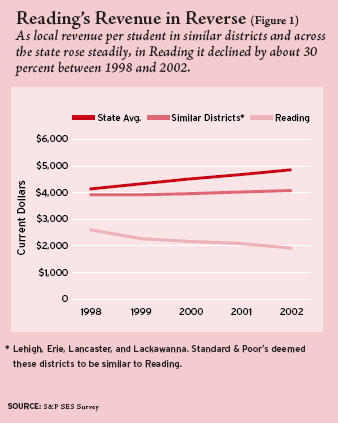
It was not surprising, then, that 13 of the district’s 19 schools were classified “in need of improvement” under the NCLB rubric; nor was the ensuing howl of “unfunded mandate” from local school officials unexpected. And when six of those schools were singled out for sanction for not having made “adequate yearly progress” and the other seven were put on a “warning list,” with the possibility of a state takeover of the system, the district petitioned the state’s Department of Education for a waiver. When the state refused to budge, Reading sued.
“The Pennsylvania Department of Education has sought to impose sanctions in one of the poorest school districts in Pennsylvania, with an inordinately large ethnic population, many of whom do not speak English,” the initial lawsuit charged. “Without any assistance from the Pennsylvania Department of Education, the Reading School District has no resources to implement any plan to improve student performance.” It claimed that the state Department of Education had “failed to provide adequate technical assistance, including direct financial assistance”; nor did the state provide a standardized test in Spanish to allow for mandated subgroup testing.
Though the first suit, which cited NCLB’s prohibitions against imposing mandates that aren’t funded, does not put a dollar figure on those mandates, outside of court, Rick Guida, the district’s lawyer, claimed that “for the Reading School District to comply (with NCLB) we’d have to double or quadruple our budget.” That, if the hyperbole were taken at face value, suggested that the district needed anywhere from an extra $250 million to more than $500 million just to comply with the federal law. (By the time of the August 6 suit, the number had changed considerably, with the district claiming that NCLB would cost $26.1 million.)
Money Talks
Money-or the lack of it-was red meat for the anti-NCLB forces. “Lack of sufficient resources” for “cash-strapped school districts,” as the National Education Association put it in a recent press release, was one of NCLB’s most troubling defects. In its amicus brief, the Pennsylvania State Education Association argued that the “sanctions under NCLB are severe and have serious implications for the financial welfare of school districts as well as rights of the school community.”
The problem, though, was that real numbers, as the two Reading suits seemed to suggest, were hard to come by. (See “Exploring the Costs of Accountability,” Feature, Spring 2004, where James Peyser and Robert Costrell wrote, “Many [NCLB] critics greatly exaggerate the shortfall of federal resources.”)
“I don’t know why Reading did this,” said Charles Zogby, a former Pennsylvania education secretary. “Did they receive support from someone else to make this a test case? From my standpoint it seems discouraging that a district with [Reading’s] academic challenges would put resources into what appears to be a fruitless legal effort.”
“It sounds to me like a savvy local official who wants to escape accountability, signing onto this national movement to defang this law,” says Robert Maranto, assistant professor of political science and public administration at Villanova University in suburban Philadelphia. Maranto, author of two upcoming works on NCLB, said, “To me the idea that they’d need a huge amount of money to bring kids up to the national average seems bogus.”
In fact, Reading School District superintendent Melissa Jamula, the daughter of a former Reading police captain, is by all accounts a powerful advocate for the district with the local business community and local and state government leaders. When the fiscal crunch hit, she launched a campaign for more state money and was largely successful in convincing community leaders that the district is doing a good job. Jamula is said to be a better politician than many of the pols.
In an e-mail alert last year announcing community meetings about the school district’s problems, the superintendent wrote: “The Reading School District is facing a financial crisis that could threaten the ability to keep our schools open the entirety of next year. The reason for this crisis is because of inadequate and inequitable funding at the state level. This is NOT a problem that can be solved locally!!” The statement perhaps packed more truth than Jamula intended.
Still, while complaining about the lack of money, Reading school officials have seen the district’s federal aid increased from $513 per student to $1,022 per student from 1998 through 2002, a boost of 99 percent. And while revenue from both state and federal sources increased at about the same rate as that of districts throughout the state, Reading averaged almost a thousand dollars more per student from outside sources than the state average (see Figure 2). Federal aid now represents some 12 percent of the district’s revenue. Pennsylvania taxpayers, despite being sued by Reading, provide some 60 percent of the district’s revenues and have bailed out the school district in each of the past two years with additional emergency funding totaling nearly $10 million. Despite the suit-or perhaps because of it-the state boosted its contributions to Reading by 12.9 percent this year. But Reading’s operating costs have increased by 14.7 percent between 1998 and 2003, though most of that was during the early years of that period. During the past several years it has managed to keep its spending growth at 11 percent or less. But the district remains on life support. This year’s budget also included a $3.5 million block grant from the state-a flexible funding source intended by state House Majority Leader Sam Smith, a Republican from Punxsutawney in western Pennsylvania, who helped design the concept, as a way to help school districts comply with NCLB.
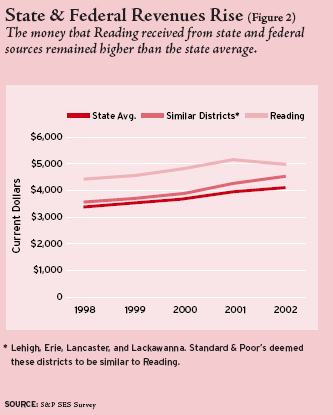
“Without the state help we’ve had to date, we’d either be-or we’d be that close to being-a distressed school district [and under state control],” says Paul Roedel, a retired steel company CEO who is chairing the Empowerment Team, which has the task of formulating a five-year financial plan for the district. “That’s what we’re working hard to avoid for Reading.” All this help is “a step in the right direction,” says Roedel, “but it’s not enough.”
Where’s the Beef?
Somewhere between the $26 million claimed in the August 6 suit and the extrajudicial assertion by Reading’s lawyer that it could take an extra $500 million (more than $30,000 per student) to fulfill the NCLB “mandate” is the question: What is “enough”?
“Time after time the mandate charge is a generality, sadly lacking in specifics,” says David Kirkpatrick, a past president of the Pennsylvania State Education Association and a pariah within the union for his advocacy of school choice. While Reading has legitimate problems, Kirkpatrick says, the “unfunded mandate” complaint is unfounded. Though the majority of Reading’s funds, like those of most other districts, come from state and federal sources, Kirkpatrick argues, local districts still retain a great deal of autonomy concerning budget allocations. He points out that the $4.3 billion the Commonwealth of Pennsylvania provides for basic education statewide is “a general grant, not earmarked and [it] can be used as they see fit to meet these supposedly excessive mandates.” This was the intention of the $3.5 million sent to Reading.
Eugene Hickok, Under Secretary of Education in the U.S. Department of Education, called the idea of having “to triple or quadruple their budget . . . just ludicrous.” The federal law is asking districts to do what they should have been doing anyway, says Hickok, who is also a former secretary of education in Pennsylvania (and a descendent of “Wild Bill”). “This isn’t meant as a hit on Reading, but what have they been spending their money on for the past 25 years?”
Though that question has not been fully explored, the line of inquiry soon began to expose the district to scrutiny it may wish it hadn’t invited.
While Melissa Jamula argues that “People who say money doesn’t make a difference have never spent a day in the Reading School District,” those who do spend some time reviewing the district’s finances would agree with Jamula-but perhaps come to a very different conclusion about the cause of the problem.
And they probably wouldn’t attribute it to NCLB. In fact, the collapse of the district’s financial house of cards, in 2003, came after three straight years of tax cuts by the school board. During that period Reading’s property owners saw their property tax rate reduced from 22 to 16 mills. Unfortunately, despite the steep reduction, Reading’s property tax rate, nearly a third higher than the state average in 1998, was still higher than the state’s average in 2002 (see Figure 3). In large part due to the plummeting property tax revenues (the biggest source of local income for school districts) what had been a $7 million surplus in 1998 had become a $5 million deficit by 2003. The district had to be bailed out by the state general assembly, which also created the Empowerment Team to create a financial roadmap for the distressed district.
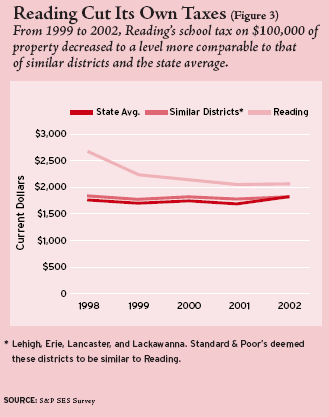
Ironically, while property tax cuts helped precipitate the district’s fiscal plunge and the repeated cries for state money, the oversight board in August recommended property tax increases-a half-mill increase annually in 2005-06 and 2007-08, along with largely unspecified spending cuts; some new spending, such as upgrading the computer system; a new “welcome center” for students; and, of course, additional state aid. Altogether, the oversight board recommended $11 million in new spending and $6.8 million in cost reductions.
Buttressing the belief that Reading was skating on fiscal thin ice that had very little to do with the temperature of NCLB was a very odd fact about the district: it happened to own a world-class art museum. Founded by a former teacher in the early 1900s and expanded by a prosperous community over the years, the Reading Public Museum today includes a natural history collection and planetarium that Paul Roedel, the museum’s treasurer, says is “worth millions.” Its website boasts “many priceless collections.”
Thus, though it shifted operations of the museum to a nonprofit foundation in 1992, one of the most disadvantaged districts in the state owns paintings by Benjamin West, Milton Avery, John Singer Sargent, George Bellows, Raphaelle Peale, Julien Dupré, Thomas Cole, Frederic Church, Edgar Degas, Henri Matisse-and dozens more.
When museum operations were shifted to the foundation, an effort was made to sell some of the assets, but “the community rose in mass against the liquidation of this community asset,” explains Roedel. To sell it today would require court approval and the chance of that ever occurring is “about zero.”
Though the museum collection is more of an irony than a solution to Reading’s problems, it is nevertheless a potent reminder of the incongruity of a district that has benefited hugely from federal and state tax dollars crying fiscal distress-and then suing-and suing again. “They’d rather have something to complain about and make excuses instead of dealing with their problems,” says Matthew Brouillette, president of the Commonwealth Foundation, a Harrisburg-based policy center. Brouillette is no fan of NCLB, but his complaint centers on states-rights issues. He has little sympathy for Reading’s financial plight. “It’s never enough,” he says.
 |
| Complicating the argument that Reading was too poor to afford NCLB was the fact that the school district owned a museum that included many valuable pieces of art.
|
The Solution-Not the Problem
“No one is denying,” says Charles Zogby, “that these districts, Reading in particular, don’t face challenges. They do. But what we had here was a system that didn’t measure performance. Now we have one that does.”
It’s that measurement, together with the threat of censure, that many observers believe is the real complaint of the Reading School District. NCLB “is pushing school districts to do things out of their comfort zones,” says Robert Maranto, who last year surveyed state education officials throughout the country about NCLB. Maranto reports that state officials see NCLB as a way of saying “shape up” to the districts getting state aid. “The local officials [who are] being held accountable hate it,” Maranto says. “Superintendents hate it. Teachers hate it. School boards hate it.”
It may mean that some schools will be “labeled a failure-and nobody likes that,” Maranto continues. Wealthy suburban districts in particular can’t fathom the thought of having a school that is failing to meet adequate yearly progress, he says.
But in most states local districts have a great deal of autonomy. And while some of the criticism of NCLB has come from high-performing districts that find the new federal regulations a nuisance, much of the complaining has come from low-performing districts like Reading that have been caught in the headlights. The myriad of social and fiscal problems faced by the district existed long before the enactment of NCLB.
In fact, Reading’s suit might just prove that NCLB is doing exactly what it is supposed to be doing: exposing struggling districts to standards of excellence they had never even imagined. And what was first considered to be the perfect district to illuminate NCLB’s defects has turned out to be a shining example of why NCLB was needed.
Brad Bumsted covers the state capitol in Harrisburg, Pennsylvania, for the Pittsburgh Tribune-Review. He is the coauthor of Murder Is the Charge, a nonfiction work about a former York, Pennsylvania, mayor.


